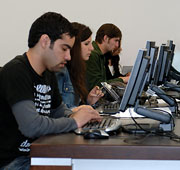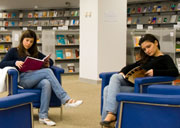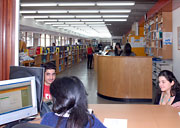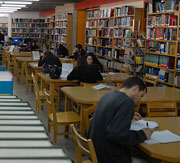Technology advances research and scholarship at LAU libraries
Learn more about the services and resources at LAU libraries, during the upcoming open house, May 4 on both campuses.
 |
|
The LAU libraries boast 132 full-text online databases of journals including more than 52,098 full-text electronic journals, and close to 50,000 electronic books, besides print books and other information records. |
 |
|
Library users benefit from ample reading areas in the Beirut-campus Riyad Nassar Library, which was completed in 2005. |
The electronic resources at LAU’s libraries have expanded considerably in recent years, leading the university to become a leading research institution in Lebanon for faculty, students and researchers.
LAU’s libraries have been able to use technology to advance their services and this has contributed to the advancement of scholarship and research substantially at the fast-expanding university, which has opened two new schools and restructured two others, in the span of two years.
Today, the research and informational needs created by faculty and students at LAU, from across seven schools, is impressively being met by the university’s strategic development of research tools and resources, including one of the most impressive journal collections in the region.
LAU’s libraries boast: 132 full-text online databases of journals — of which some are updated every 15 minutes — that include more than 52,098 full-text electronic journals, close to 50,000 electronic books (of which 16,000 are owned by LAU), 393,000 print books and other information records. Of the 2,450 journals and magazines that the libraries carry, 70 percent will be available online by 2013.
“Our online databases are growing on a yearly basis by 4-6 percent,” says Cendrella S. Habre, the director of the Riyad Nassar Library at LAU Beirut. She says technology has facilitated the impressive growth and expansion of LAU’s library collection, facilities and resources, resulting in library resources that are second to none in the country.
“By 2013, our plan is to have only 250 journal titles in print in RNL and 250 in the Byblos library,” says Habre. “Right now we have almost 800 in print.”
One of the most noteworthy services the libraries offer is an international interlibrary loan and document delivery service.
This also extends to a range of services available to library users, including specialized research training sessions, and a live chat service to ask for assistance.
In addition to research tools, the libraries also offer both desktop and laptop computers for borrowing, as well as state-of-the-art network-connected furniture.
The success of the new and constantly evolving services and facilities offered by LAU’s libraries is evident in attendance numbers year on year. Habre says in Beirut attendance has increased by 34 percent yearly from the fall of 2008-09 to the fall of 2009-10, although she says borrowing books has decreased because more information is now available online.
Byblos library expansion on the horizon
 |
|
Some of the services the libraries offer include an international interlibrary loan and document delivery service, specialized research training sessions, and a live chat service to ask for assistance. |
 |
|
A new and significantly expanded structure — to be named after Lebanese writer Khalil Gibran — is on the horizon for the Byblos-campus library. |
Joseph S. Hage is the director of LAU’s Byblos-campus library, for which a new and significantly expanded structure — to be named after the revered Lebanese writer Khalil Gibran — is scheduled to begin construction in the coming few years.
First established in 1987 at the former LAU campus in Amsheet, the Byblos library moved to its current location in 1991 with about 10,000 volumes in a space of 600 square meters. Student enrollment at the time was approximately 1,000 students at that campus. Now with an enrollment of close to 2,400 students in Byblos, in addition to its local stacks, the library has three remote access storage areas in different buildings.
With the opening of the new School of Medicine and School of Nursing, as well as the restructuring of the School of Engineering — all based on the Byblos campus, in addition to the other schools of Pharmacy, Arts and Sciences, Business, and Architecture and Design, the Byblos campus is set to grow rapidly in both facilities and student enrollment over the coming years.
Hage says that, “naturally, the increase in student numbers leads to an increase in the library attendance.” He explains that the average student attendance at present is 750 students per day. However, Hage says the current Byblos-library facilities are already stretched too thin.
Despite the increase in general and specialized electronic databases at the Byblos library, Hage says the circulation of books has increased by 100 percent over the last 10 years due to an increase of student numbers, and a highly efficient inter-campus loan system that is fueled by a rich collection.
That said, expansion is on the horizon for the fast-growing Byblos library, and a steering committee for the new library has been established, and has met with the architects who will be soon submitting part of the plans, says Hage.
The LAU libraries are holding an open house for students, faculty and staff on May 4 to provide more information about their services and resources.

More
Latest Stories
- LAU Simulation Models Celebrate 20 Years of Learning, Leadership and Service
- LAU Stands Out on the Sustainability Scores
- Michael Haddad Walks Again for Climate Change and Food Security
- AI in Clinical Practice: Tools, Ethics, and the Human Touch
- Interior Design Students Honor the Past by Designing the Future
- LAU’s 100th Commencement Continues With Beirut Class of 2025
- Wadad Halwani: Mourning, Memory and Movement
- LAU’s 100th Commencement Begins With Byblos Class of 2025

